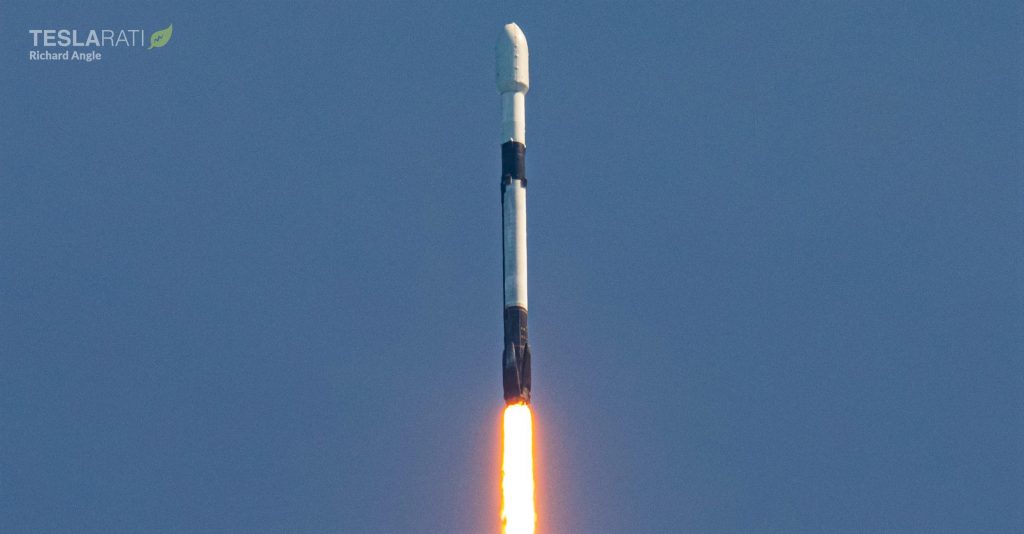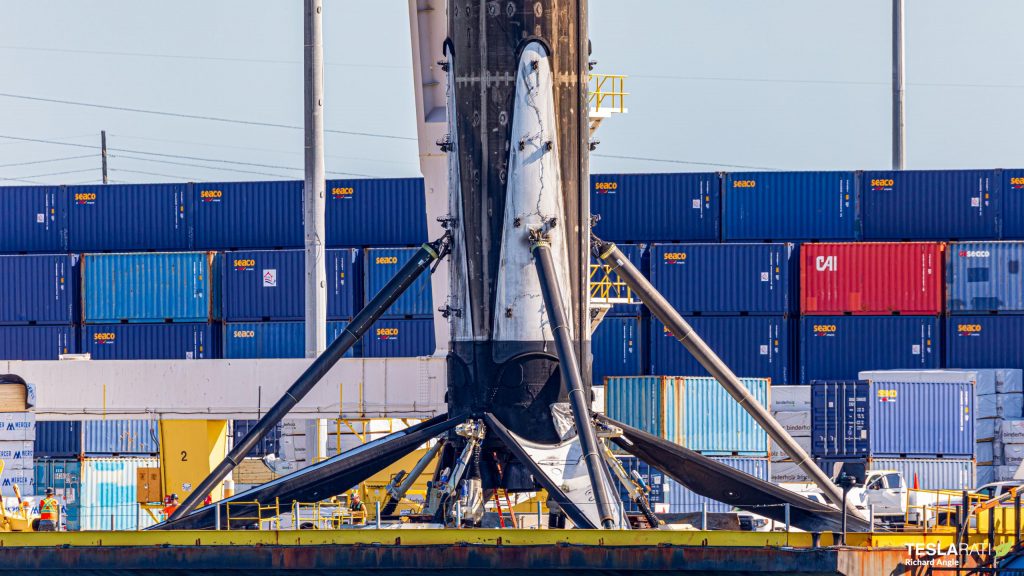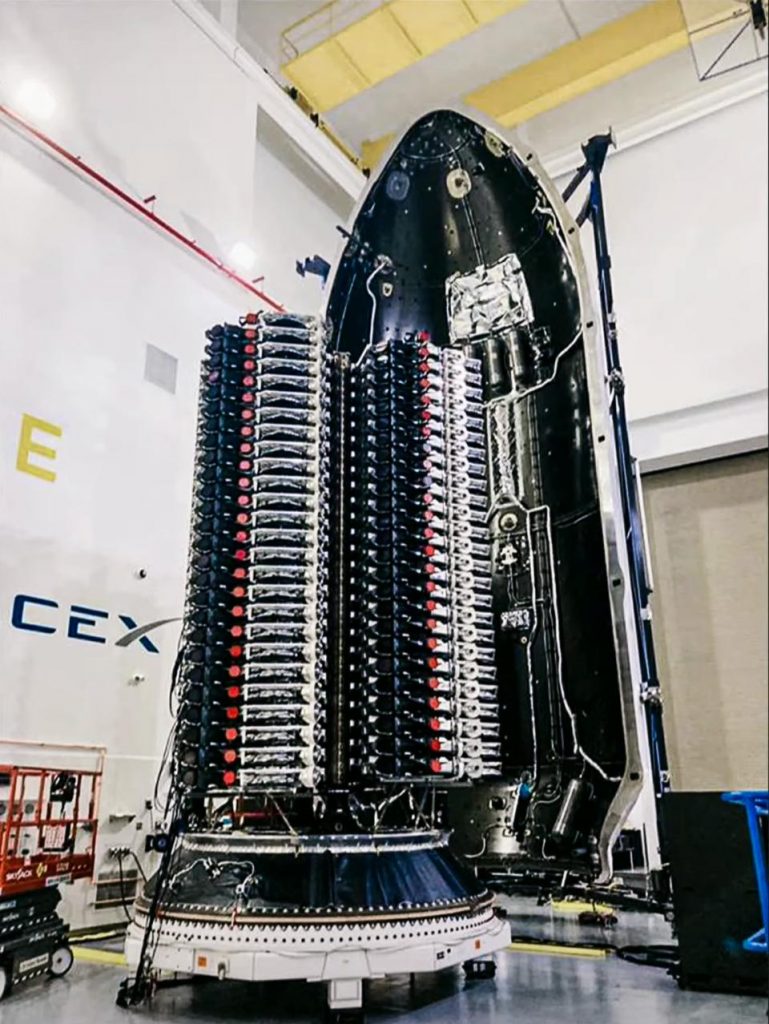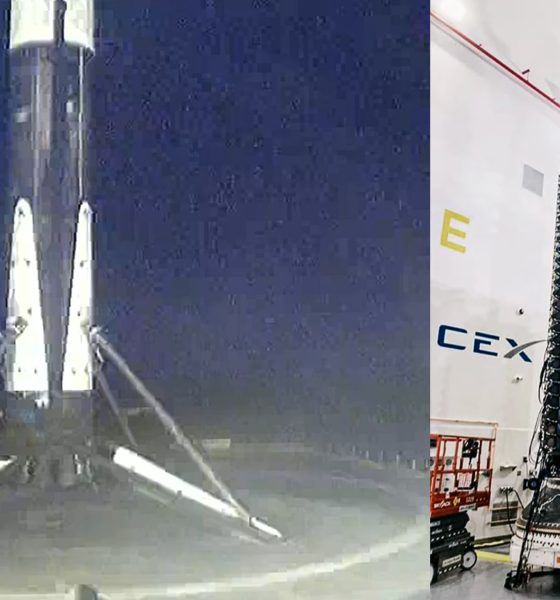A SpaceX Falcon 9 rocket has successfully launched 51 upgraded laser-linked Starlink satellites from its Vandenberg Space Force Base (VSFB) – the first mission of its kind out of the company’s west coast launch facilities.
Known as Starlink Group 2-1, the mission debuted the operational design of new V1.5 Starlink satellites with laser interlinks that will eventually let the constellation route its own communications almost anywhere on Earth – regardless of ground station locations. Aside from potentially allowing SpaceX to flout local regulations in countries with oppressive communications restrictions, firewalls, or censors, those lasers will also give Starlink the ability to easily deliver internet to moving vehicles – including aircraft traveling over oceans – and in even the remotest locations with no ground infrastructure for hundreds of miles.
Independent of its main purpose, the Starlink 2-1 mission also saw SpaceX tie its internal Falcon booster reusability record. Following in the footsteps of younger booster B1051, Falcon 9 B1049, which debuted in September 2018, successfully completed its tenth orbital-class launch and landing with Starlink 2-1. Originally scheduled to launch as early as July, apparent hiccups mass-producing new Starlink V1.5 satellites and their laser interlinks delayed the mission by about two months, causing SpaceX to launch just once in 11 weeks preceding the mission.


In comparison, Falcon 9 B1051 debuted in March 2019 and became the first booster to cross the ten-flight mark in May 2021, just 26 months later. B1049 took almost exactly 36 months to accomplish the same feat – almost 40% slower but still faster than any of the four NASA Space Shuttles that successfully reached similar milestones.
SpaceX also says that Starlink 2-1 is the 24th time the company has successfully launched a flight-proven Falcon 9 payload fairing, reusing a normally expendable component that CEO Elon Musk once likened to a pallet of $6 million in cash. Ultimately, the company gave up on efforts to catch parasailing fairing halves out of the air with giant ship-based nets and has instead refocused on perfecting the reuse of fairings that gently land in the ocean. For the most part, that’s been accomplished by designing Starlink satellites themselves to tolerate a much dirtier, louder launch environment than most other spacecraft, letting SpaceX remove sponge-like foam sound suppression tiles normally found inside fairings and worry less about needing to deep-clean the giant nosecones.
Nevertheless, SpaceX has technically launched 150+ commercial payloads – and one major geostationary commsat (SXM-7) – over three launches with flight-proven fairings, suggesting that there is a path to wider commercial acceptance of the brand new technology and the direct cost savings it brings.

With Starlink 2-1 safely in orbit, SpaceX now likely operates more space-based laser interlinks than the rest of the world combined. Eventually, once enough satellites with laser links are in orbit, SpaceX will be able to dramatically expand Starlink coverage almost independent of the construction of new ground stations – a heavily bureaucratic process that has proven to make for agonizingly slow progress in a number of the 15+ countries with active service. Instead of requiring that the satellite a given user terminal (dish) is communicating with be in direct line of sight of a ground station dish to route a user’s communications, thus connecting them to the internet, a constellation with widespread lasers will allow a dish’s active satellite to relay that connection through other satellites.
As a result, ground stations can be significantly further away from the users they end up supporting. Further, given that SpaceX has no plans to stop building new ground stations despite the bureaucratic hell it can involve, a well-linked Starlink constellation will ultimately be able to beat most wired connections by using lasers to route user communications to the ground stations closest to the real-world servers or services they’re trying to access.
Stay tuned for updates on SpaceX’s next polar Starlink launch(es) with ‘space lasers.’

News
Nvidia CEO Jensen Huang explains difference between Tesla FSD and Alpamayo
“Tesla’s FSD stack is completely world-class,” the Nvidia CEO said.

NVIDIA CEO Jensen Huang has offered high praise for Tesla’s Full Self-Driving (FSD) system during a Q&A at CES 2026, calling it “world-class” and “state-of-the-art” in design, training, and performance.
More importantly, he also shared some insights about the key differences between FSD and Nvidia’s recently announced Alpamayo system.
Jensen Huang’s praise for Tesla FSD
Nvidia made headlines at CES following its announcement of Alpamayo, which uses artificial intelligence to accelerate the development of autonomous driving solutions. Due to its focus on AI, many started speculating that Alpamayo would be a direct rival to FSD. This was somewhat addressed by Elon Musk, who predicted that “they will find that it’s easy to get to 99% and then super hard to solve the long tail of the distribution.”
During his Q&A, Nvidia CEO Jensen Huang was asked about the difference between FSD and Alpamayo. His response was extensive:
“Tesla’s FSD stack is completely world-class. They’ve been working on it for quite some time. It’s world-class not only in the number of miles it’s accumulated, but in the way it’s designed, the way they do training, data collection, curation, synthetic data generation, and all of their simulation technologies.
“Of course, the latest generation is end-to-end Full Self-Driving—meaning it’s one large model trained end to end. And so… Elon’s AD system is, in every way, 100% state-of-the-art. I’m really quite impressed by the technology. I have it, and I drive it in our house, and it works incredibly well,” the Nvidia CEO said.
Nvidia’s platform approach vs Tesla’s integration
Huang also stated that Nvidia’s Alpamayo system was built around a fundamentally different philosophy from Tesla’s. Rather than developing self-driving cars itself, Nvidia supplies the full autonomous technology stack for other companies to use.
“Nvidia doesn’t build self-driving cars. We build the full stack so others can,” Huang said, explaining that Nvidia provides separate systems for training, simulation, and in-vehicle computing, all supported by shared software.
He added that customers can adopt as much or as little of the platform as they need, noting that Nvidia works across the industry, including with Tesla on training systems and companies like Waymo, XPeng, and Nuro on vehicle computing.
“So our system is really quite pervasive because we’re a technology platform provider. That’s the primary difference. There’s no question in our mind that, of the billion cars on the road today, in another 10 years’ time, hundreds of millions of them will have great autonomous capability. This is likely one of the largest, fastest-growing technology industries over the next decade.”
He also emphasized Nvidia’s open approach, saying the company open-sources its models and helps partners train their own systems. “We’re not a self-driving car company. We’re enabling the autonomous industry,” Huang said.
Elon Musk
Elon Musk confirms xAI’s purchase of five 380 MW natural gas turbines
The deal, which was confirmed by Musk on X, highlights xAI’s effort to aggressively scale its operations.

xAI, Elon Musk’s artificial intelligence startup, has purchased five additional 380 MW natural gas turbines from South Korea’s Doosan Enerbility to power its growing supercomputer clusters.
The deal, which was confirmed by Musk on X, highlights xAI’s effort to aggressively scale its operations.
xAI’s turbine deal details
News of xAI’s new turbines was shared on social media platform X, with user @SemiAnalysis_ stating that the turbines were produced by South Korea’s Doosan Enerbility. As noted in an Asian Business Daily report, Doosan Enerbility announced last October that it signed a contract to supply two 380 MW gas turbines for a major U.S. tech company. Doosan later noted in December that it secured an order for three more 380 MW gas turbines.
As per the X user, the gas turbines would power an additional 600,000+ GB200 NVL72 equivalent size cluster. This should make xAI’s facilities among the largest in the world. In a reply, Elon Musk confirmed that xAI did purchase the turbines. “True,” Musk wrote in a post on X.
xAI’s ambitions
Recent reports have indicated that xAI closed an upsized $20 billion Series E funding round, exceeding the initial $15 billion target to fuel rapid infrastructure scaling and AI product development. The funding, as per the AI startup, “will accelerate our world-leading infrastructure buildout, enable the rapid development and deployment of transformative AI products.”
The company also teased the rollout of its upcoming frontier AI model. “Looking ahead, Grok 5 is currently in training, and we are focused on launching innovative new consumer and enterprise products that harness the power of Grok, Colossus, and 𝕏 to transform how we live, work, and play,” xAI wrote in a post on its website.
Elon Musk
Elon Musk’s xAI closes upsized $20B Series E funding round
xAI announced the investment round in a post on its official website.

xAI has closed an upsized $20 billion Series E funding round, exceeding the initial $15 billion target to fuel rapid infrastructure scaling and AI product development.
xAI announced the investment round in a post on its official website.
A $20 billion Series E round
As noted by the artificial intelligence startup in its post, the Series E funding round attracted a diverse group of investors, including Valor Equity Partners, Stepstone Group, Fidelity Management & Research Company, Qatar Investment Authority, MGX, and Baron Capital Group, among others.
Strategic partners NVIDIA and Cisco Investments also continued support for building the world’s largest GPU clusters.
As xAI stated, “This financing will accelerate our world-leading infrastructure buildout, enable the rapid development and deployment of transformative AI products reaching billions of users, and fuel groundbreaking research advancing xAI’s core mission: Understanding the Universe.”
xAI’s core mission
Th Series E funding builds on xAI’s previous rounds, powering Grok advancements and massive compute expansions like the Memphis supercluster. The upsized demand reflects growing recognition of xAI’s potential in frontier AI.
xAI also highlighted several of its breakthroughs in 2025, from the buildout of Colossus I and II, which ended with over 1 million H100 GPU equivalents, and the rollout of the Grok 4 Series, Grok Voice, and Grok Imagine, among others. The company also confirmed that work is already underway to train the flagship large language model’s next iteration, Grok 5.
“Looking ahead, Grok 5 is currently in training, and we are focused on launching innovative new consumer and enterprise products that harness the power of Grok, Colossus, and 𝕏 to transform how we live, work, and play,” xAI wrote.










